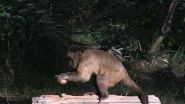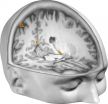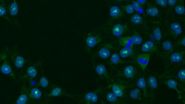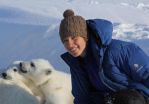Can China sustain annual pollution reductions?
2015-04-30
(Press-News.org) China's government and other sources say that the country's carbon-dioxide emissions flattened out between 2013 and 2014. The leveling-off was a remarkable feat that could set the country on a course to beating its own goals for lowering emissions. But this optimistic outcome hinges on China overcoming some serious energy challenges, according to an article in Chemical & Engineering News (C&EN), the weekly newsmagazine of the American Chemical Society.
Steven Gibb, a senior editor at C&EN, reports that a number of factors could help explain the emissions plateau. China reduced its carbon-intensive coal consumption by 2.9 percent in 2014 after a decade of double-digit annual growth. It has invested $90 billion in renewable energy such as solar and wind. And it is shifting toward a more service-oriented economy.
But China still faces daunting challenges in sustaining control over its emissions. In particular, the country's strategy to reach its carbon reduction goals had called for building one new nuclear power plant every three weeks. The government shelved those plans after Japan's 2011 Fukushima disaster. Whether China can find new ways stay on its emission-cutting course remains to be seen.
INFORMATION:
The American Chemical Society is a nonprofit organization chartered by the U.S. Congress. With more than 158,000 members, ACS is the world's largest scientific society and a global leader in providing access to chemistry-related research through its multiple databases, peer-reviewed journals and scientific conferences. Its main offices are in Washington, D.C., and Columbus, Ohio.
To automatically receive news releases from the American Chemical Society, contact newsroom@acs.org.
Follow us:
Twitter
Facebook END
ELSE PRESS RELEASES FROM THIS DATE:
2015-04-30
How and when does mom feed her embryo? We humans, like most mammals, experience pregnancy where a mother supplies nutrition directly to the embryo as it develops. But we're in the minority.
Most members of the animal kingdom supply eggs with nutritious yolk before they are fertilized. With this yolk supply, fertilized eggs develop as embryos in the environment outside the mother's body. For over a century, the scientific understanding of matrotrophy ("mother-feeding") of an embryo developing inside a mom's body has come from vertebrate animals, especially mammals like ...
2015-04-30
The latest Special Issue from ecancermedicalscience is dedicated to the memory of our late friend, Dr Mario Sideri.
The Special Issue, "Prevention of gynaecological cancers: in memory of Mario Sideri," consists of nine articles centred around Dr Sideri's favoured research topic.
Dr Sideri was one of the first doctors in the world to identify the connection between the human papillomavirus (HPV) and cervical cancer.
He served as the Director of the Preventive Gynecology Unit at the European Institute of Oncology (IEO) in Milan from 1994 until his tragic death in June ...
2015-04-30
When it comes to cracking nuts, wild bearded capuchin monkeys are more skilled than anyone had given them credit for, according to researchers who report new findings in the Cell Press journal Current Biology on April 30.
The monkeys are known to use stone "hammers" to crack nuts. The new study shows that the monkeys are quite careful about the amount of force delivered to those nuts. They adjust the force applied with each strike based on the condition of the nutshell, making it less likely that they'll end up smashing the tasty kernel inside.
"Wild bearded capuchin ...
2015-04-30
Bats are masters of flight in the night sky, capable of steep nosedives and sharp turns that put our best aircraft to shame. Although the role of echolocation in bats' impressive midair maneuvering has been extensively studied, the contribution of touch has been largely overlooked. A study published April 30 in Cell Reports shows, for the first time, that a unique array of sensory receptors in the wing provides feedback to a bat during flight. The findings also suggest that neurons in the bat brain respond to incoming airflow and touch signals, triggering rapid adjustments ...
2015-04-30
Neuroscientists have perfected a chemical-genetic remote control for brain circuitry and behavior. This evolving technology can now sequentially switch the same neurons - and the behaviors they mediate - on-and-off in mice, say researchers funded by the National Institutes of Health. Such bidirectional control is pivotal for decoding the brain workings of complex behaviors. The findings are the first to be published from the first wave of NIH grants awarded last fall under the BRAIN Initiative.
"With its new push-pull control, this tool sharpens the cutting edge of ...
2015-04-30
The feeling of being inside one's own body is not as self-evident as one might think. In a new study from Sweden's Karolinska Institutet, neuroscientists created an out-of-body illusion in participants placed inside a brain scanner. They then used the illusion to perceptually 'teleport' the participants to different locations in a room and show that the perceived location of the bodily self can be decoded from activity patterns in specific brain regions.
The sense of owning one's body and being located somewhere in space is so fundamental that we usually take it for granted. ...
2015-04-30
First study to show pattern of telomere changes at multiple time points as cancer develops
Telomeres can look 15 years older in people developing cancer
Pattern suggests when cancer hijacks the cell's aging process
CHICAGO -- A distinct pattern in the changing length of blood telomeres, the protective end caps on our DNA strands, can predict cancer many years before actual diagnosis, according to a new study from Northwestern Medicine in collaboration with Harvard University.
The pattern -- a rapid shortening followed by a stabilization three or four years before ...
2015-04-30
Rochester, Minn. -- Over the last decade, numerous studies have shown that many Americans have low vitamin D levels and as a result, vitamin D supplement use has climbed in recent years. Vitamin D has been shown to boost bone health and it may play a role in preventing diabetes, cancer, cardiovascular disease and other illnesses. In light of the increased use of vitamin D supplements, Mayo Clinic researchers set out to learn more about the health of those with high vitamin D levels. They found that toxic levels are actually rare.
Their study appears in the May issue of ...
2015-04-30
LA JOLLA--Stem cells, which have the potential to turn into any kind of cell, offer the tantalizing possibility of generating new tissues for organ replacements, stroke victims and patients of many other diseases. Now, scientists at the Salk Institute have uncovered details about stem cell growth that could help improve regenerative therapies.
While it was known that two key cellular processes--called Wnt and Activin--were needed for stem cells to grow into specific mature cells, no one knew exactly how these pathways worked together. The details of how Wnt and Activin ...
2015-04-30
Many human communities want answers about the current status and future of Arctic marine mammals, including scientists who dedicate their lives to study them and indigenous people whose traditional ways of subsistence are intertwined with the fate of species such as ice seals, narwhals, walruses and polar bears.
But there are many unknowns about the current status of 11 species of marine mammals who depend on Arctic sea ice to live, feed and breed, and about how their fragile habitat will evolve in a warming world.
A recently published multinational study attempted ...
LAST 30 PRESS RELEASES:
[Press-News.org] Can China sustain annual pollution reductions?




